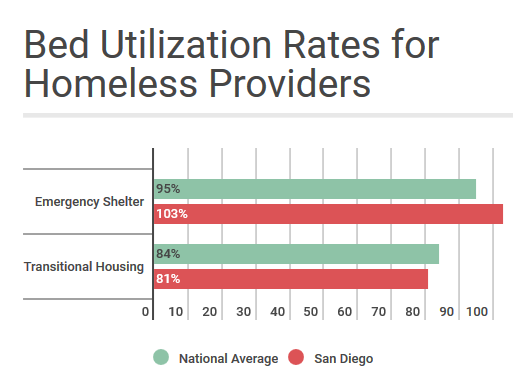That 1,500 figure includes 435 vouchers for veterans. Those are not physical beds. And even with them it is often hard to find beds.
It also includes other forms of housing assistance and permanent solutions that usually can’t be offered up easily.
Let’s break down where the numbers come from and how many actual beds may actually be sitting available.
Every January, the nonprofit Regional Task Force on the Homeless tallies the homeless living on county streets and in canyons, and those sleeping in emergency shelters or in so-called safe haven or transitional programs. The tally they reach serves as the estimate of the region’s homeless population.
The group also produces another report that breaks down homeless housing options utilized at the time of the census. This is what Ward was referencing.
This report tracks more than just the short-term beds. It also records the use of multiple housing assistance resources and permanent supportive housing beds. When a homeless person accesses one of those permanent beds, she’s no longer considered homeless and thus is not included in the task force’s local estimate of the homeless population.
Yet homeless San Diegans can seldom find immediate housing through any of those routes.
A homeless veteran or family that receives a voucher or cash assistance usually must first find a place to live, a process that can take weeks or even months.
There were more immediate resources that weren’t being used when the task force did its count in January. The group counted 696 vacant shelter, safe haven and transitional housing beds on top of hundreds of other unused resources such as vouchers and temporary help. One could credibly argue, as Ward has, that those latter resources could be used more efficiently –and be easier to use, too. But it’s not as if a full 1,500 beds were sitting empty during the annual tally.
There are also caveats even for that smaller number.
A unit designed for families might include four beds, for example. But if a smaller family spent the night there and utilized only two of the beds, that’d register as two vacant beds, even though the empty beds couldn’t be filled with people on the street.
Ward is wrong when he implies 30 percent of the homeless could be in beds if things worked better. But that doesn’t mean there isn’t room for improvement.
And the federal Housing and Urban Development Department and local leaders do keep an eye on whether beds are being used.
A HUD spokesman said the agency encourages programs to maintain at least an 80 percent utilization rate. Last year, San Diego’s shorter-term programs posted a combined 87 percent occupancy rate.
A 2014 report to Congress also offers some insight on how San Diego’s utilization rates for the two most common short-term bed programs compare with those elsewhere. San Diego’s emergency shelter occupancy last January actually exceeded the national, year-round average while its transitional housing – which is meant to help the homeless stabilize before they seek permanent housing – was slightly below the national figure.

That’s not to say local homeless providers or the local officials overseeing funding decisions and progress are satisfied with the status quo.
A committee of the regional Continuum of Care Council, the countywide group monitoring efforts to fight homelessness, has begun a systemwide analysis that aims to assess the demand for certain types of beds to ensure greater efficiency and effectiveness. There’s also been amovement away from transitional programs, which have long been San Diego’s dominant homeless-serving approach.
Ward and his campaign manager told me that analysis is needed.
They said the statement we’re examining was meant to trigger a discussion about utilization of homeless-serving resources and that whether you incorporate beds or housing assistance in the analysis, San Diego needs to do better.
“I think the point is still accurate that we have existing resources available to use,” Ward said.
His campaign updated its statement on Wednesday to say “approximately 1,500 beds, vouchers, and resources were not used during the annual census” in 2015.
Indeed, San Diego’s sometimes struggled to use resources.
But Ward’s initial claim that 1,500 beds weren’t filled during the annual point-in-time is false and oversimplifies the situation. It overstates the number of vacant beds during last year’s homeless census and thus the percentage of unsheltered homeless that might have used them.
[divider] [/divider]
Originally posted Voice of San Diego.



